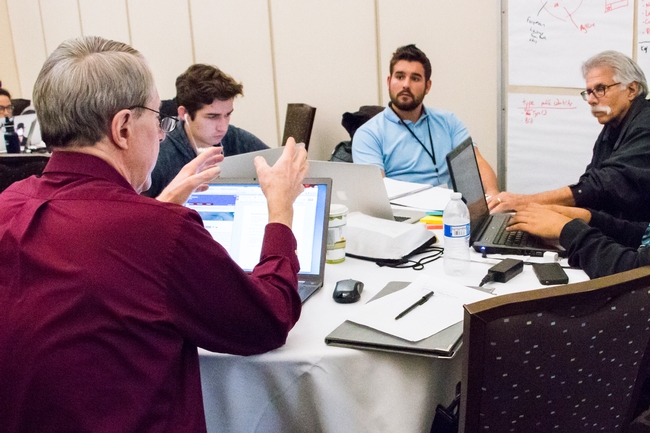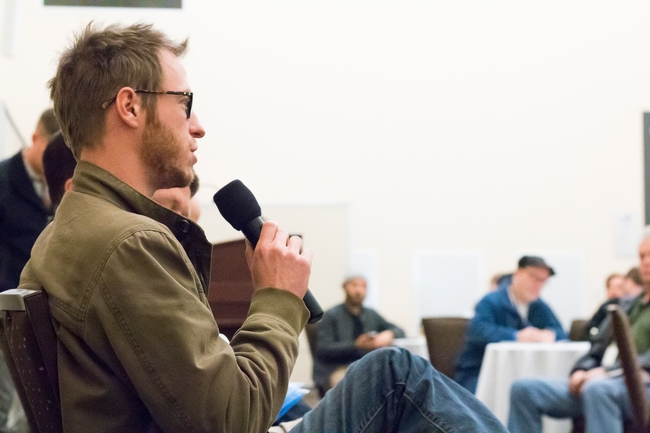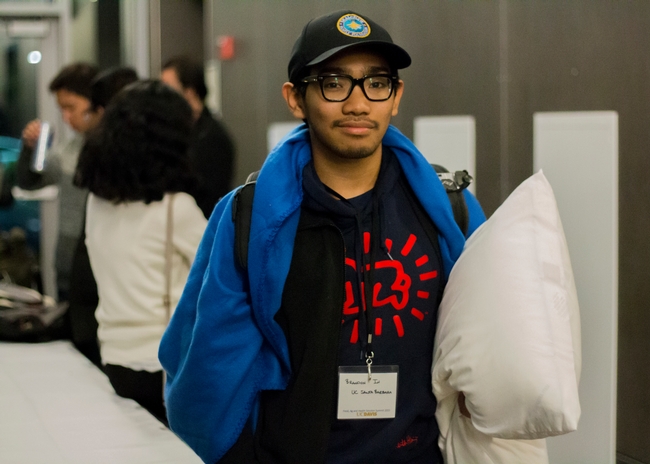Hackers compete for best ag app

Old coffee cups, laptops streaming code, baggy eyes deprived of sleep: all the usual signs of hackers at work. But a poorly lit hacker hideaway this was not.
The overnight competition, called the Apps for Ag Hackathon, featured farmers, food science students and UC Agriculture and Natural Resources (UC ANR) extension specialists. They teamed up with software developers to craft quick technology solutions that addressed deep challenges in the planet's food systems.
A summit for solutions
The hackathon, in partnership with the World Food Center at the University of California, Davis, was one of a series of events at the Food, Ag and Health Solution Summit, held Dec. 1-3 at UC Davis. Each chapter of the summit brought together uncommon collaborators to partner on a range of possible agtech solutions.
On the first day, the World Food Center's Precision Ag Workshop focused on paving a long-term roadmap with potential industry partners. Ranging from small startups to global corporations and well-established California commodity associations, each organization was investing in front-end irrigation technologies and looking for new opportunities to collaborate with academic researchers.
The pace switched to rapid-fire for a panel at the summit forum on day three: entrepreneurs from eight different agtech startups had seven minutes to pitch their products to the audience. Delving deeper into the world of agtech financing, a later panel discussion asked professional investors what they would look for in startup models.

Hacking through the night
The hackathon ran alongside the forum and other summit events. Participants had only a 32-hour window to fuse together teams, brainstorm a product, develop rough cuts of their software and present their final pitches to the judges.
"People get a little low on sleep, they get a little silly, the creative juices really start flowing," said Apps for Ag organizer Patrick Dosier to Capital Public Radio. "Software developers often have their headphones on and they're in the zone writing code."
With $10,000 in total prize money and a paid trip to Zurich, Switzerland, at stake, the hackers in their final minutes before turning in their presentation slides were actually focusing more on the human network. The conversations evolved away from talk of web hosting software and .png files to meeting for a coffee later and talking about ways to collaborate in the future. While some groups rehearsed their pitches, others exchanged business cards and phone numbers.

From the Central Valley to Silicon Valley
By presentation time at the tail end of the conference, the hackers were visibly exhausted, some carrying pillows and others seen napping in vacant rooms. Thanks to blankets donated by AT&T, many were able to grab quick rests during the hack.
On stage, the Ag for Hire team showed off their app. It connected contract farmworkers to farmers looking to hire. A "LinkedIn for agricultural labor," the app idea took first place at the competition.
"As a worker myself, it's hard to find a job where I can apply my skills," said team member Alejandro Avalos, who has worked on farms since he was 12 years old. "Our app helps a worker find a job based on his skills and actually get a decent wage for it."
Nick Doherty, a UC Davis undergraduate student and recent pick for Apple's 20-Under-20 list, was also on the team.
Along with the $5,000 award, the team will be flown to the Thought for Food Global Summit in Switzerland next year.
Second place and a $3,000 prize went to the team for CropRescue, an app that allows growers to communicate directly with food banks to make excess food donations easier and more efficient. The final $1,500 prize went to the Green Thumb team, which created a task-tracking app to enable better communication among crop advisers, growers and foremen.
UC innovation goes global
Patrick Brown, a UC Davis plant nutrition professor and pomologist at the Agricultural Experiment Station, advised the hackathon teams, as well as taking part in other events. UC ANR small farms advisor Margaret Lloyd also participated in the summit.
Sponsors for the Solution Summit prizes included Intel, UC ANR, the UC Global Food Initiative, UC Innovation Alliances and the Royse Law Firm. The Global Food Initiative also sponsored travel for two doctoral candidates at UC Berkeley and UC Riverside. The Solution Summit was held in partnership with the Innovation Institute for Food and Health, the Mixing Bowl Hub and the SARTA AgStart incubator.
See the Food Hackathon that inspired the competition.
Author: Brad Hooker
